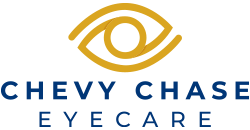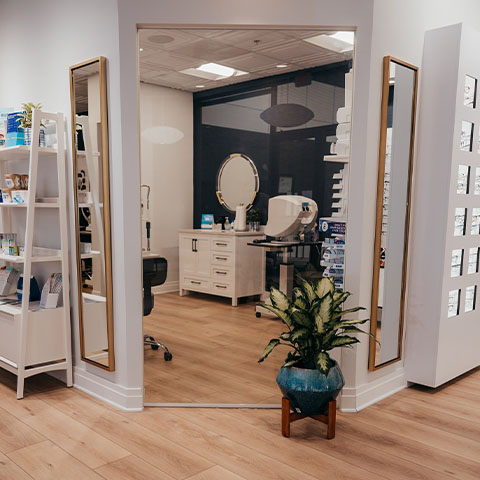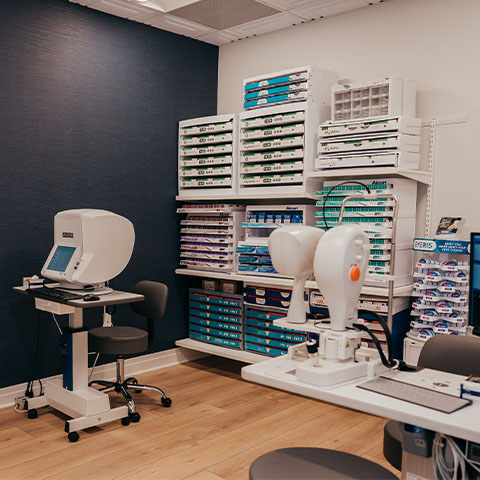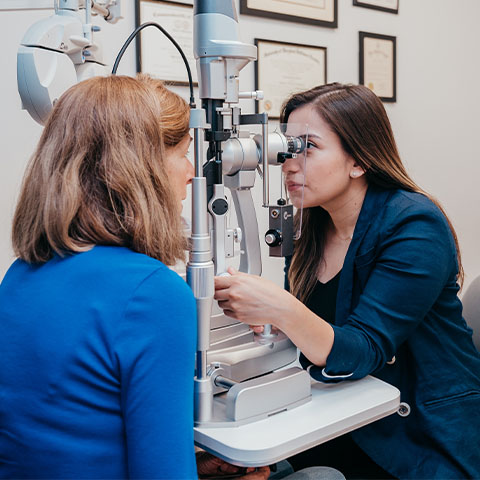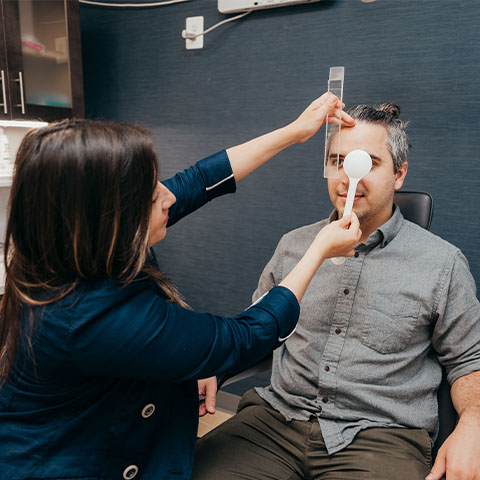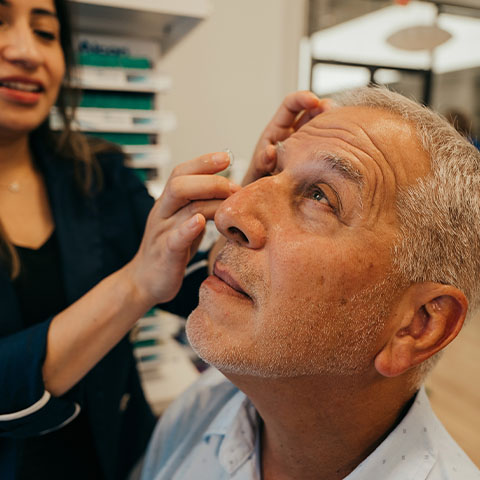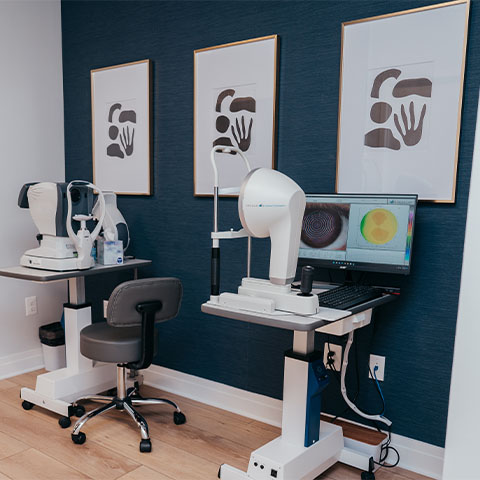Helping Your Eyes Work Together
Your eyes need to work as a team to help you achieve clear, crisp, comfortable vision. But if your eyes are misaligned, it can lead to numerous symptoms such as blurry vision, eye fatigue, light sensitivity, and more. This issue may sometimes be interpreted as a learning-related concern like ADHD and reading problems.
At Chevy Chase Eyecare, we have a unique understanding of binocular vision dysfunction (BVD)—an issue that affects how well your eyes work together—thanks to our specialty training from Dr. Debby Feinberg of the NeuroVisual Medicine Institute. We see patients from all over the country, many traveling across state lines to find help from our team.
Even if you aren’t aware of BVD, we’ll be happy to walk you through its symptoms and our strategies for managing it. All you need to do is book an appointment and let our team handle the rest.
What Is BVD?
Binocular vision dysfunction is a condition where both eyes have difficulty working together as a team, causing an image misalignment. The body attempts to correct the issue by overusing and straining the eye muscles, leading to numerous symptoms that can affect both children and adults.
When the misalignment is severe, it can cause double vision. However, in most cases, the misalignment is very subtle, making it difficult to identify without the help of a professional. Even when the misalignment is small and physically unnoticeable, the symptoms can be debilitating in all aspects of life.
What Causes BVD?
Experts believe at least 10% of the population struggles with BVD, but very few know they have it. This is because BVD can be misdiagnosed as a number of different issues, which we’ll get into in our next section.
BVD can develop for several reasons including neurological disorders, a stroke, traumatic brain injuries, or facial asymmetry. These issues can affect how well you use the muscles in your eyes, leading to BVD symptoms. However, some people might not experience symptoms until they’re 40 years old.
BVD in Adults vs. BVD in Children
Both children and adults can experience BVD, but symptoms might differ. BVD is difficult to diagnose because it can manifest as symptoms of other physical, neurological, or learning-related concerns, such as:
- ADD/ADHD
- Agoraphobia
- Anxiety/panic disorders
- Persistent post-concussive symptoms
- Cervical misalignment
- Ménière disease
- BPPV (benign paroxysmal positional vertigo)
- Psychogenic dizziness/chronic subjective dizziness
- PPPD (persistent postural-perceptual dizziness)
- Vestibular migraine/migraine-associated vertigo (MAV)
- Migraines
- MS (Multiple Sclerosis)
- Reading & learning disabilities
- Sinus problems
- Stroke
- TMJ disorders
You might also experience different symptoms based on your age. Some symptoms can be subtle, such as general eye discomfort or even regular headaches, but others can be more overt, such as continuous head tilting.
We’ve developed a detailed questionnaire that adults and children can take to help determine their BVD risk and might benefit from a neuro-visual examination. Before booking an appointment, please fill out the questionnaires.
Adult Symptoms
Common adult BVD symptoms include:
- Dizziness
- Reading problems
- Nausea
- Neck pain
- Headaches
- Vertigo
- Anxiety
- Head tilting
Children’s Symptoms
Common child BVD symptoms include:
- Difficulties with reading and writing
- Playing with toys very close to their face
- Head tilting
- Sitting close to the TV
- Difficulty identifying shapes, colors, and numbers
- Difficulty seeing the class board
- Frequently bumping into objects
- Difficulty playing games or sports
- Stomach aches and headaches at school or away from home
- Light sensitivity
- Covering one eye to see
- Squinting
Diagnosing BVD
We recommend first visiting your primary care physician or specialist to rule out causes other than BVD for your symptoms. If no other reason is found, BVD might be the issue. Visit us, and we can start working on diagnosing and treating your symptoms.
We tailor our process according to our patients and their unique needs, but some of the most common steps include:
- Filling out a specialized questionnaire designed to help diagnose those who have BVD.
- Completing a detailed health history form.
- Performing an eye exam to determine the need for a lens prescription.
- Performing a specialty neuro-visual evaluation to determine if visual misalignment is present.
- Fitting you with a trial version of your new prescription if we diagnose you with BVD. Most people notice a significant improvement in their symptoms within just a few minutes of putting on the trial lenses.
You can expect to spend approximately 1.5 hours in our office during your visit.
Treating Your Symptoms
After performing a comprehensive neuro-visual evaluation, we’ll determine the extent of your eye misalignment and prescribe a special pair of micro-prism lenses.
Micro-prism lenses help realign images between your eyes and reduce symptoms caused by BVD. After your initial evaluation appointment, we’ll have you come in for another appointment in about 4 to 6 weeks to fine-tune your prescription and provide further support.
Some may notice a difference immediately after putting on micro-prism lenses, but others may need additional adjustments to help address their symptoms. In either case, we’re here to help you through your journey, and we’re more than happy to answer any questions you have throughout your treatment.
Make the Most of Your Vision
Find out how we can support your sight today and book a neuro-visual evaluation with the team at Chevy Chase Eyecare today.
Visit Our Location
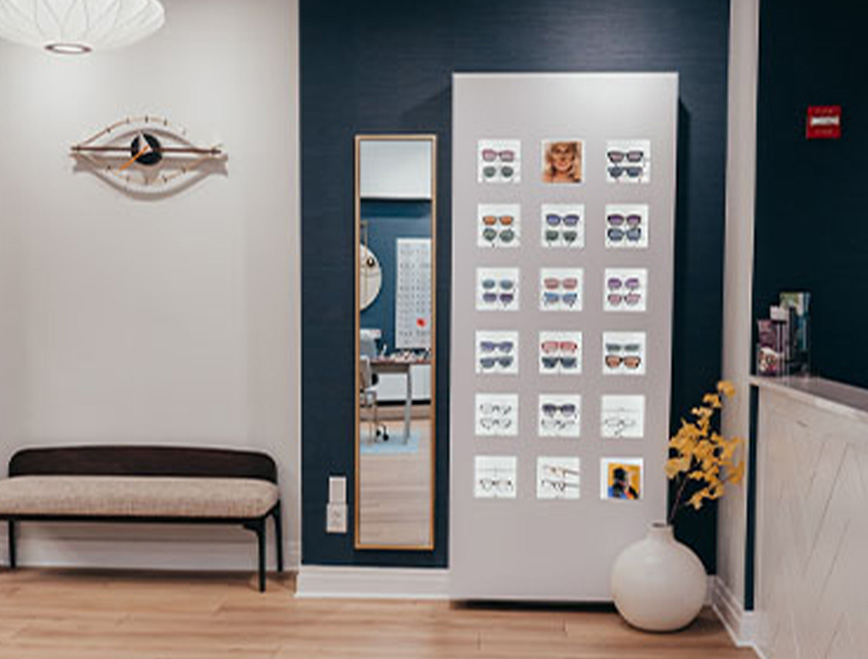
Our Address
- 8401 Connecticut Ave., Ste 102
- Chevy Chase, MD 20815
Contact Us
- Phone: 301-242-3927
- Email: [email protected]
Clinic Hours
- Monday: 9:00 AM – 5:00 PM
- Tuesday: 9:00 AM – 5:00 PM
- Wednesday: 9:00 AM – 5:00 PM
- Thursday: 9:00 AM – 5:00 PM
- Friday: 9:00 AM – 5:00 PM
- Saturday: Closed
- Sunday: Closed

Our Brands








